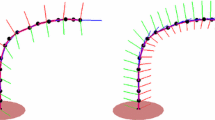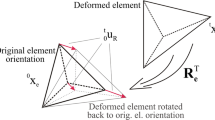Abstract
This paper presents a time integration method for realtime simulation of extremely deformable objects subject to geometrically nonlinear hyperelasticity. In the presented method, the equation of motion of the system is discretized by the backward Euler method, and linearly approximated through the first-order Taylor expansion. The approximate linear equation is solved with the quasi-minimal residual method (QMR), which is an iterative linear equation solver for non-symmetric or indefinite matrices. The solution is then corrected considering the nonlinear term that is omitted at the Taylor expansion. The method does not demand the constitutive law to guarantee the positive definiteness of the stiffness matrix. Experimental results show that the presented method realizes stable behavior of the simulated model under such deformation that the tetrahedral elements are almost flattened. It is also shown that QMR outperforms the biconjugate gradient stabilized method (BiCGStab) in this application.











Similar content being viewed by others
Notes
This result is as expected because QMR performs two matrix-vector multiplications per iteration while CG performs only one.
The criteria \(e_{1,k}\) and \(e_{2,k}\) were not computed in the experiments of Fig. 3, but was performed in another session because the computation of \(e_{1,k}\) and \(e_{2,k}\) resulted in nonnegligible computational time. This computation resulted in roughly 10 % reduction in the number of QMR iterations.
References
Baraff, D., Witkin, A.: Large steps in cloth simulation. In: Proceedings of ACM SIGGRAPH, pp. 43–54 (1998)
Barbič, J.: Exact corotational linear FEM stiffness matrix. Tech. Rep. University of Southern California (2012)
Barbič, J., James, D.L.: Real-time subspace integration for St. Venant-Kirchhoff deformable models. ACM Trans. Graph. 24(3), 982–990 (2005)
Barbič, J., Zhao, Y.: Real-time large-deformation substructuring. ACM Trans. Graph. (2011)
Bickel, B., Wicke, M., Gross, M.: Adaptive simulation of electrical discharges. In: Proceedings of Vision, Modeling, and Visualization, pp. 209–216 (2006)
Bouaziz, S., Martin, S., Li, T., Kavan, L., Pauly, M.: Projective dynamics: fusing constraint projections for fast simulation. ACM Trans. Graph. 33(4), 154 (2014)
Brochu, T., Keeler, T., Bridson, R.: Linear-time smoke animation with vortex sheet meshes. In: Proceedings of the ACM SIGGRAPH/Eurographics Symposium on Computer Animation, pp. 87–95 (2012)
Chao, I., Pinkall, U., Sanan, P., Schröder, P.: A simple geometric model for elastic deformations. ACM Trans. Graph. 29(4), 38 (2010)
Civit-Flores, O., Susín, A.: Robust treatment of degenerate elements in interactive corotational FEM simulations. Comput. Graph. Forum 33(6), 298–309 (2014)
Delingette, H.: Biquadratic and quadratic springs for modeling St.Venant Kirchhoff materials. In: Proceedings of 4th International Symposium on Biomedical Simulation. Lecture Notes in Computer Science, vol. 5104, pp. 40–48. Springer, New York (2008)
Desbrun, M., Schröder, P., Barr, A.H.: Interactive animation of structured deformable objects. In: Proceedings of the 1999 Conference on Graphics Interface, pp. 1–8 (1999)
Fletcher, R.: Conjugate gradient methods for indefinite systems. In: Dold, A., Eckmann, B. (eds.) Numerical Analysis. Lecture Notes in Mathematics, vol. 506, pp. 73–89. Springer, New York (1976)
Freund, R.W., Nachtigal, N.M.: QMR: a quasi-minimal residual method for non-Hermitian linear system. Numer. Math. 60(1), 315–339 (1991)
Freund, R.W., Nachtigal, N.M.: An implementation of the QMR method based on coupled two-term recurrences. SIAM J. Sci. Comput. 15(2), 313–337 (1994)
Hirota, K., Kaneko, T.: Haptic representation of elastic objects. Presence 10(5), 525–536 (2001)
Irving, G., Teran, J., Fedkiw, R.: Invertible finite elements for robust simulation of large deformation. In: Proceedings of Eurographics/ACM SIGGRAPH Symposium on Computer Animation, pp. 131–140 (2004)
Irving, G., Teran, J., Fedkiw, R.: Tetrahedral and hexahedral invertible finite elements. Graph. Models 68(2), 66–89 (2006)
Kapre, N., DeHon, A.: Optimistic parallelization of floating-point accumulation. In: Proceedings of 18th IEEE Symposium on Computer Arithmetic, pp. 205–216 (2007)
Kikuuwe, R., Tabuchi, H., Yamamoto, M.: An edge-based computationally efficient formulation of Saint Venant-Kirchhoff tetrahedral finite elements. ACM Trans. Graph. 28(1), 8 (2009)
Liu, T., Bargteil, A.W., O’Brien, J.F., Kavan, L.: Fast simulation of mass-spring systems. ACM Trans. Graph. 32(6), 214 (2013)
Lloyd, B.A., Székely, G., Harders, M.: Identification of spring parameters for deformable object simulation. IEEE Trans. Visual Comput. Graph. 13(5), 1081–1094 (2007)
McAdams, A., Zhu, Y., Selle, A., Empey, M., Tamstorf, R., Teran, J., Sifakis, E.: Efficient elasticity for character skinning with contact and collisions. ACM Trans. Graph. 30(4), 37 (2011) (article 37)
Müller, M., Gross, M.: Interactive virtual materials. In: Proceedings of Graphics Interface, pp. 239–246 (2004)
Myronenko, A., Song, X.: On the closed-form solution of the rotation matrix arising in computer vision problems (2009). arXiv:0904.1613
Nakao, M., Kuroda, T., Oyama, H., Sakaguchi, G., Komeda, M.: Physics-based simulation of surgical fields for preoperative strategic planning. J. Med. Syst. 30(5), 371–380 (2006)
Natsupakpong, S., Çavuşoğlu, M.C.: Determination of elasticity parameters in lumped element (mass-spring) models of deformable objects. Graph. Models 72(6), 61–73 (2010)
Nesme, M., Payan, Y., Faure, F.: Efficient, physically plausible finite elements. In: Eurographics, short presentations, pp. 77–80 (2005)
Nienhuys, H.W., van der Stappen, F.A.: Combining finite element deformation with cutting for surgery simulations. In: Proceedings of Eurographics, pp. 43–52 (2000)
Nocedal, J., Wright, S.J.: Numerical optimization, 2nd edn. Springer Series in Operations Research and Financial Engineering. Springer, New York (2006)
Parker, E.G., O’Brien, J.F.: Real-time deformation and fracture in a game environment. In: Proceedings of 2009 ACM SIGGRAPH/Eurographics Symposium on Computer Animation, pp. 165–175 (2009)
Patterson, T., Mitchell, N., Sifakis, E.: Simulation of complex nonlinear elastic bodies using lattice deformers. ACM Trans. Graph. 31(6), 197 (2012)
Peterlík, I., Sedef, M., Basdogan, C., Matyska, L.: Real-time visio-haptic interaction with static soft tissue models having geometric and material nonlinearity. Comput. Graph. 34(1), 43–54 (2010)
Picinbono, G., Delingette, H., Ayache, N.: Non-linear anisotropic elasticity for real-time surgery simulation. Graph. Models 65(5), 305–321 (2003)
Saad, Y.: Iterative methods for sparse linear systems, 2nd edn. SIAM (2003)
Saad, Y., Schultz, M.H.: GMRES: a generalized minimal residual algorithm for solving nonsymmetric linear systems. SIAM J. Sci. Comput. 7(3), 856–869 (1986)
Saupin, G., Duriez, C., Cotin, S., Grisoni, L.: Efficient contact modeling using compliance warping. In: Proceedings of Computer Graphics International (2008)
Schmedding, R., Teschner, M.: Inversion handling for stable deformable modeling. Visual Comput. 24(7–9), 625–633 (2008)
Sin, F.S., Schroeder, D., Barbič, J.: Vega: Non-linear FEM deformable object simulator. Comput. Graph. Forum 32(1), 36–48 (2013)
Song, C., Zhang, H., Wang, X., Han, J., Wang, H.: Fast corotational simulation for example-driven deformation. Comput. Graph. 40, 49–57 (2014)
Sonneveld, P.: CGS, a fast Lanczos-type solver for nonsymmetric linear systems. SIAM J. Sci. Stat. Comput. 10(1), 36–52 (1989)
Stomakhin, A., Howes, R., Schroeder, C., Teran, J.M.: Energetically consistent invertible elasticity. In: Proceedings of ACM SIGGRAPH/Eurographics Symposium on Computer Animation, pp. 25–32 (2012)
Teran, J., Sifakis, E., Irving, G., Fedkiw, R.: Robust quasistatic finite elements and flesh simulation. In: Proceedings of the 2005 ACM SIGGRAPH/Eurographics Symposium on Computer Animation, pp. 181–190 (2005)
van der Vorst, H.A.: Bi-CGSTAB: a fast and smoothly converging variant of Bi-CG for the solution of nonsymmetric linear systems. SIAM J. Sci. Comput. 13(2), 631–644 (1992)
Wang, H.: A Chebyshev semi-iterative approach for accelerating projective and position-based dynamics. ACM Trans. Graph. 34(6), 246 (2015)
Zhong, H., Wachowiak, M.P., Peters, T.M.: A real time finite element based tissue simulation method incorporating nonlinear elastic behavior. Comput. Methods Biomech. Biomed. Eng. 8(3), 177–189 (2005)
Acknowledgments
The surface meshes of Stanford Armadillo and the “bunny” were obtained from the Web site of Stanford Computer Graphics Laboratory (http://graphics.stanford.edu/data/3Dscanrep/). The surface mesh of the “dinosaur” was obtained courtesy of an unknown creator from the AIM@SHAPE Shape Repository (http://shapes.aim-at-shape.net/). They were converted into tetrahedral meshes by using Adventure TetMesh provided by the ADVENTURE Project (http://adventure.sys.t.u-tokyo.ac.jp/).
Author information
Authors and Affiliations
Corresponding author
Additional information
This work was supported in part by Grant-in-Aid for Exploratory Research, No. 25540044, from Japan Society for the Promotion of Science.
Electronic supplementary material
Below is the link to the electronic supplementary material.
Supplementary material 1 (wmv 51884 KB)
Rights and permissions
About this article
Cite this article
Kikuuwe, R. A time-integration method for stable simulation of extremely deformable hyperelastic objects. Vis Comput 33, 1335–1346 (2017). https://doi.org/10.1007/s00371-016-1225-0
Published:
Issue Date:
DOI: https://doi.org/10.1007/s00371-016-1225-0




